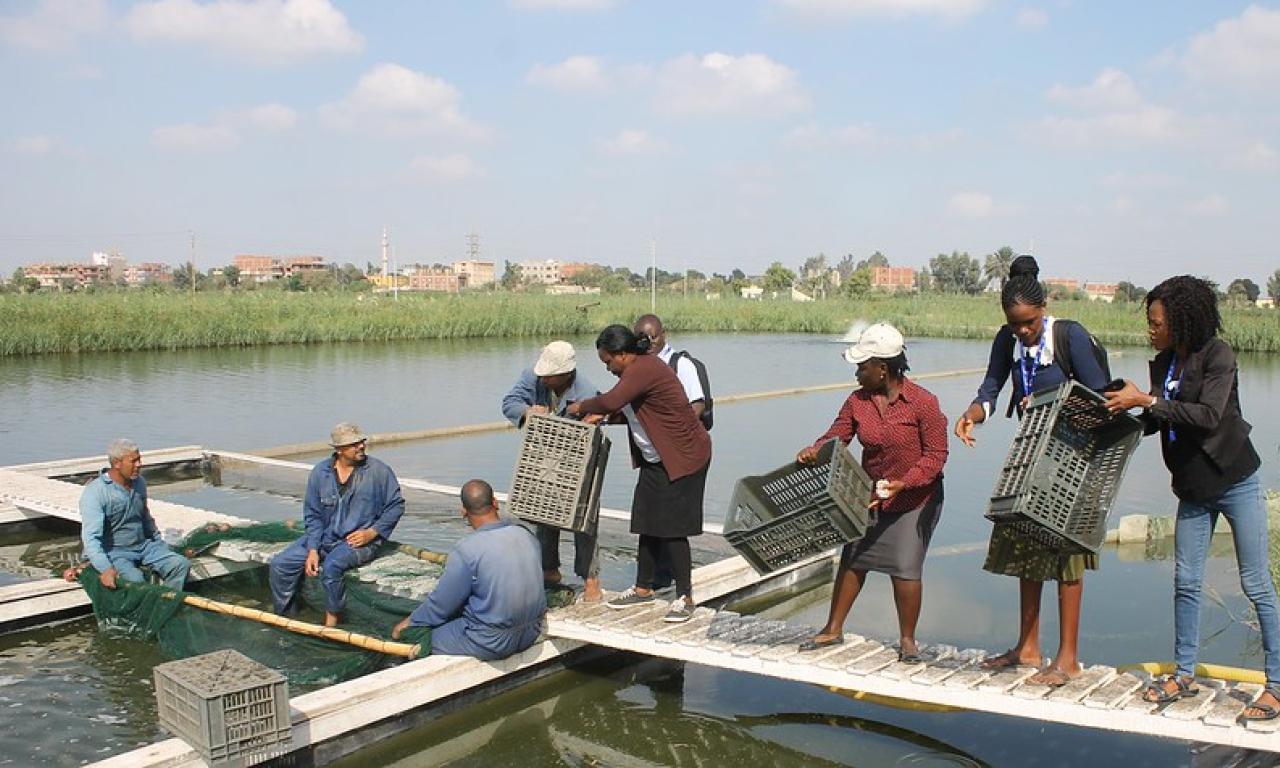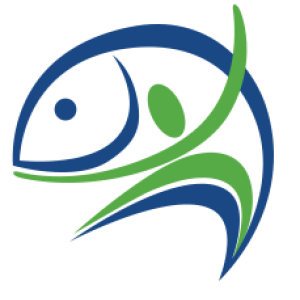
Aquatic food systems in Africa face many challenges and chronic underinvestment. WorldFish is trying to change that with the Fish for Africa Innovation Hub.
One of the best parts of working in the aquatic foods sector is the few times each week when I come across another exciting innovation or technology that’s been developed for the sector or has applications for it. This list is long and varied—from varieties of fish that are more affordable and nutritious for low-income countries to produce and consume, to rapid diagnostic kits for identifying and tracking fish diseases, to nutrient-packed fish-based products for children, and digital sensors for tracking fisheries to avoid their depletion—it is often the case that for every major problem in the sector, multiple solutions have been developed and tested.
This is good news, especially for the aquatic foods systems in Africa, which face many complex challenges. African aquatic foods systems—encompassing everything from tilapia production in Egypt to catfish processing in Nigeria, and beyond, are some of the most promising yet untapped sectors of African food systems. They employ over 20 million people, many of them women; generate value exceeding $20 billion USD annually; and feed tens of millions of Africans, providing much-needed protein and micronutrients. They do all of these despite the many constraints they face, including access to only the most rudimentary methods and technology, and receiving less than 10 percent of all the investments going into African agriculture.
This historical underinvestment means that Africa and Africans are not fully benefiting from the returns that the sub-sector can deliver—a monumental loss considering how these returns can transform African economies and lives. To highlight a few of these potential returns: aquatic foods are incredibly promising in their ability to deliver climate adaptation, gender equality, nutritious and affordable diets, increased and more equitable prosperity, and ecosystem restoration, among many others. They are also one of the few agricultural sectors in which African women dominate several major parts of the value chain, especially post-harvest, therefore they can deliver significant returns on gender inclusion.
For a long time, this space has done a lot with the most limited resources, but emerging or worsening realities, such as climate change, and the threats they pose to food security, stability, and ending poverty mean that this trend of underinvestment must change soon. Not only are significantly more investments needed, but they must be structured in specific ways to deliver the most returns for people and planet. This gap between the sector’s potential and the underinvestment it has historically faced prompted WorldFish to begin developing the Fish for Africa Innovation Hub, building on over 45 years of groundbreaking research in aquatic food systems in Africa, Asia, and the Pacific.
Shrinking the Resource Gap
The Fish for Africa Innovation Hub will significantly shrink this investment and resource gap on multiple fronts and using multiple approaches, some of which are detailed below.
De-risking Investments in Aquatic Foods
Data-driven approaches currently being implemented have demonstrated that more investment can be attracted into agriculture if financial institutions and other stakeholders receive support to properly manage and distribute the risks of investing in the sector. Building on this work, multiple mechanisms for de-risking aquatic foods markets in Africa will be explored and co-developed by the Hub, including first-loss guarantees and other special-purpose blended finance vehicles, which will enable a range of businesses to receive the financial and technical resources they need to scale. This will catalyze a larger wave of investments into aquatic foods, especially from current investors with strong interest but low-risk appetites.
Creating Incentives for Multiple Actors
While the sector’s stakeholders all care about delivering impact, their motivations, needs, and priorities can differ, so incentive mechanisms will have to be adapted to suit the needs of different stakeholders. These range from attracting private investors after refining the business models of very promising businesses, to enabling the development of the right policies and policy environment by designing public policy innovations.
Identifying and Fostering Innovations & Technologies
The Hub will identify a pipeline of innovations and technologies ready for the sector’s use and help stakeholders to figure out how exactly these solutions need to be adapted to suit the contexts of specific African markets. Through innovation challenges, innovation dialogues, and similar efforts, the Hub will match innovations and technologies to the resources and knowledge needed to figure out how exactly they can scale. A wide array of solutions are ready for this type of refinement, from gender-inclusive financing models for the sector, which have been tested in a few markets but need to be more widely tested before they can be scaled, to methods of fish production which crop farmers can integrate into their existing crop production systems to diversify their incomes and diets, and new methods of breeding which significantly increase the nutrients available in aquatic foods.
Leveraging Digital Technology & the Digital Economy
As the emergence of a wave of very promising African tech startups has shown, there is great opportunity in using digital solutions to strengthen the foundational infrastructure of a market while creating jobs for young people and catalyzing the creation of new businesses and solutions. Digital technologies and the digital economy present significant opportunities for aquatic foods, even beyond the deployment of digital products in different parts of aquatic food systems. The Hub will develop strong connections to digital actors and enable the development of a suite of digital solutions for the sector, some that will address the underlying infrastructural challenges in African aquatic food systems.
Addressing Intellectual Property Challenges
One of the major barriers to scaling innovations across Africa is the limited protection available for intellectual property (IP), which prevents businesses and inventors from growing their investments. Through its market development services, the Hub will deepen the understanding of the kinds of IP models that can succeed in African food systems, and how these models can benefit inventors and entrepreneurs willing to make strategic bets about food markets in Africa.
Building Capacity
The capacity challenges of the sector remain significant, and many kinds of capacity development models are needed, from fee-based and highly customized training programs that combine in-person and virtual modules, to short, subsidized virtual courses that can be accessed by anyone on the continent, as well as mentorship programs that enable young Africans to receive the support they need as they advance in the sector. Building on WorldFish’s extensive expertise and experience training thousands of people out of its research facilities in Abbassa, Egypt and in close collaboration with partners, the Hub will build out sustainable models that respond to the capacity development needs and budgets of various stakeholders.
Convening Stakeholders
It is our belief that all of the people who care deeply about aquatic foods systems in Africa are not yet talking enough to each other or collaborating sufficiently—from the women who process and sell fish in African markets, to the investors funding the latest fish-based products. Through aquatic food dialogues and other targeted, focused convenings, the Hub will bring these stakeholders together to develop creative and transformative solutions to the sector’s needs. These will also serve as excellent avenues for identifying the research needs of the sector, as a more informed and collaborative aquatic foods system translates to the growth of more demand-driven research.
Supporting Successful Scaling
While innovation hubs typically focus on the design phase, we’ll be primarily focused on the post proof-of-concept phase, at which point the basics of an innovation have been figured out, and the long journey to successful scaling is just beginning. We’ll help to fine-tune these innovations (many of them emerging from research), prepare them for scaling, refine their business models to ensure maximum impact can be delivered, and work with the sector’s stakeholders to ensure this technology-driven transformation is inclusive, responsive to the sector’s needs, and enables stakeholders to deliver the impact they seek. This approach has been selected for many reasons, one of them being that the Hub is not trying to replicate many of the exciting research efforts ongoing across developing countries, nor do we want to attempt to fill in the shoes of traditional investors. Rather, we’d like to be a bridge between both parts of the transformation process, as the post-proof of concept, pre-scaling phase is often where many great innovations emerging from research are lost.
Through this portfolio of initiatives, the Fish for Africa Innovation Hub will become a catalyst for transforming African aquatic food systems and using these food systems to deliver on Africa’s climate, gender equality, nutrition, and economic transformation goals. The Hub will need all the partners, supporters, and friends it can find, and we hope that you’ll join us on this exciting journey to discover exactly what is possible if we make the necessary investments in transforming aquatic food systems in Africa.
###
This article was written by WorldFish's Global Lead in Business Development, Faridah Ibrahim, and was originally published as part of the 'Harvesting Tomorrow' blog series by The Chicago Council’s Center on Global Food and Agriculture.
